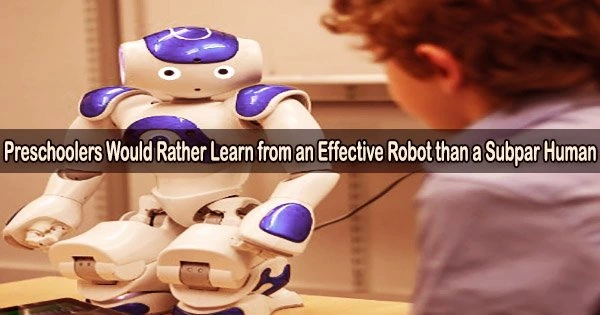Who do children prefer to learn from? Even infants can choose the best informant, according to earlier studies. But would young children rather learn from a smart robot than a dumb one?
The response mostly varies on age, according to a recent report by Concordia researchers that was published in the Journal of Cognition and Development.
Two preschool age groups one of three-year-olds and the other of five-year-olds were compared in the study. The kids took part in Zoom sessions that featured a video of a young lady and a little robot named Nao that has humanoid features like a head, face, torso, limbs, and legs sitting side by side.
The human would wrongly refer to known objects between them while the robot would accurately identify them, such as calling a car a book, a ball a shoe, and a cup a dog.
Next, the two groups of children were presented with unfamiliar items: the top of a turkey baster, a roll of twine and a silicone muffin container. Both the robot and the human used different nonsense terms like “mido,” “toma,” “fep” and “dax” to label the objects. Then the youngsters were asked what the object was called, supporting either the robot- or human-provided label.
The five-year-olds were significantly more likely to use the term offered by the robot than the person, although the three-year-olds showed no preference for one word over another.
“We can see that by age five, children are choosing to learn from a competent teacher over someone who is more familiar to them even if the competent teacher is a robot,” says the paper’s lead author, PhD candidate Anna-Elisabeth Baumann. Horizon Postdoctoral Fellow Elizabeth Goldman and undergraduate research assistant Alexandra Meltzer also contributed to the study.
It is important to emphasize that we see robots as tools to study how children can learn from both human and non-human agents. As technology use increases, and as children interact with technological devices more, it is important for us to understand how technology can be a tool to help facilitate their learning.
Elizabeth Goldman
Professor and Concordia University Chair of Developmental Cybernetics Diane Poulin-Dubois in the Department of Psychology supervised the study.
A smaller robot dubbed Cozmo, shaped like a truck, was used in place of the humanoid Nao in the studies that were conducted again with fresh sets of three and five-year-old children. The outcomes were consistent with those shown with the humanoid robot, indicating that the morphology of the robot has no bearing on the children’s use of selective trust.
In addition to the labeling task, the researchers also gave the participants a basic biology assignment, says Baumann. The kids were asked if the interior components of strange animals and robots were made of organic organs or mechanical gears.
The three-year-olds seemed perplexed, giving the robots both mechanical and organic interior components. The five-year-olds, however, were considerably more inclined to say that the robots should exclusively contain mechanical components.
“This data tells us that the children will choose to learn from a robot even though they know it is not like them. They know that the robot is mechanical,” says Baumann.
Being right is better than being human
Although there is a lot of literature on the advantages of employing robots as teaching tools for kids, the researchers point out that the majority of these studies only look at one robot informant or two robots competing with one another.
They claim that this is the first study to examine whether youngsters prioritize social ties and likeness over competence when deciding which sources to believe and learn from.
Poulin-Dubois notes that the earlier publication she co-authored with Goldman and Baumann serves as the foundation for this investigation. This study demonstrates that by the age of five, kids view robots as representations of social agents, just like adults do.
“Older preschoolers know that robots have mechanical insides, but they still anthropomorphize them. Like adults, these children attribute certain human-like qualities to robots, such as the ability to talk, think and feel,” she says.
“It is important to emphasize that we see robots as tools to study how children can learn from both human and non-human agents,” concludes Goldman. “As technology use increases, and as children interact with technological devices more, it is important for us to understand how technology can be a tool to help facilitate their learning.”
















